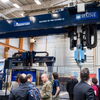Fabric of history
A dusty old textile machine sits idle in a former mill in Lewiston, halted mid-production as if the workers operating it years ago simply went to lunch and never came back. A 6-foot-long mass of steel and spools, the machine drips with white thread, partially woven into fringe once intended to line the edges of a fine bedspread. The delicate fringe, covered in lint, pools near the floor, abandoned.
But Rachel Desgrosseilliers calls this relic of Lewiston’s textile history a “gem.” And the machine’s aura of a work in progress surely rings true for Desgrosseilliers, executive director of the Museum L-A, who many credit with reviving civic pride in Lewiston through her leadership of the nonprofit. Now, as the museum prepares to move out of the Bates Mill with hopes of attracting an even wider audience, its work is far from finished.
Desgrosseilliers, a former hospital administrator and nun who launched an area hot air balloon festival, never expected to be running a museum. Born and raised in Lewiston, she had planned to semi-retire five years ago when she agreed to help find a suitable director for the museum, someone who knew the community and possessed strong organizational skills. “Then all of a sudden, everyone was staring at me,” she says, rolling her eyes and chuckling at the thought of the 25-hour workweek she signed up for, which has since lengthened to double that. “Running a hospital, you’re dealing with people’s lives,” she says. “It’s the same thing here. We’re validating lives.”
With a sophistication recognized as uncommon outside the professional museum community, Desgrosseilliers has guided the nonprofit toward preserving and honoring the area’s working-class history. She’s organized reunions of Lewiston-Auburn’s aging millworkers, saved innumerable artifacts from the trash heap and convinced a property owner, with only a handwritten purchase option and a one dollar bill, to sell her the museum’s future home.
Perhaps most of all, Desgrosseilliers has engaged the community in restoring pride in its history as a mill town. One former loom fixer, his old tools in hand, told her at the first millworkers’ reunion that he could die in peace knowing that someone cared about what he’d done during his life.
Into the light
A group of third-graders from a Lewiston elementary school sits quietly in kid-sized chairs in the museum’s main exhibit area. With school budgets drained of money for field trips, Desgrosseilliers has turned to grants in recent years to bring school children to Museum L-A as part of its mission to “connect generations,” she says.
Desgrosseilliers herself embodies that mission. Her father, Cyrille Baillargeon, was a millworker. Now 92, he sacrificed his hearing to his 38 years among the booming machines of the Bates Mill. Desgrosseilliers remembers wondering, as a child, why her father always returned home with his eyes, ears and even bellybutton filled with lint. She finally understood, much later.
After the mills were shuttered, people didn’t talk about Lewiston-Auburn’s blue-collar history, Desgrosseilliers says, as the area sought to shake its mill town identity. “We were the Industrial Revolution,” she says. “We built these communities. Why not talk about it?” As the community lost its mills and shoe shops, something was lost in the push toward modernity. “We never allowed the people to grieve that,” she says.
Desgrosseilliers spent the summer of 2004 at local fairs and other gatherings, stopping members of older generations to ask if they were former millworkers. That led to the first of two millworkers’ reunions, which drew nearly 600 people, many of whom recorded oral histories as part of an exhibit called “Portraits and Voices: Workers of Seven Mills.” A collaboration with Bates College students, the exhibit featured a cell phone tour that allowed visitors to dial in to their own phones to hear the words of a millworker depicted in a photograph in front of them. A publication documenting the exhibit won a first place award from the New England Museum Association.
“The collaboration and quality of work, the depth of the resource and the use of technology are things even established museums aspire to,” Kate Viens, executive director of the association, says of Museum L-A. Last year, Desgrosseilliers spoke as part of a panel on conceptual planning at the association’s annual conference. The talk focused on how to make sound decisions in terms of determining audience, facilities, budget and programming, Viens says. “Museum L-A has been such a stellar example of that,” she says.
Desgrosseilliers and her staff are consistent participants in professional museum community events, a rare occurrence among volunteer-based organizations, Viens says.
Annual visitors to the museum have swelled from 234 in 2004, not including attendees of the first millworker reunion, to 3,000 so far this year. Next year, Desgros seilliers expects 6,500 visitors. According to the Inlook Group of Portsmouth, N.H., Museum L-A’s collections represent one of the largest documentations of the Industrial Revolution in New England, and possibly the country. Desgrosseilliers organized a concert of 1940s and ’50s music this summer that drew more than 1,500 people to the mill. Everyone had such a good time at the de facto reunion that Desgrosseilliers had to remind a few attendees to leave, at 12:30 a.m.
Collecting memories
Desgrosseilliers points to a map hanging on the wall on the museum’s second floor, a detailed diagram of the area dating back to the early 1920s. Its creator, in painstaking text and sketches, outlined railroad tracks, building footprints and streets in one of the many fire maps drawn up by the mill’s insurance company. The map, and many of the museum’s other priceless artifacts, would be in a landfill somewhere if Desgrosseilliers hadn’t pulled it out of the back of a dump truck.
Museum L-A might also not have a new home if Desgrosseilliers hadn’t been willing to get her hands dirty in another way. After the city sold the Bates Mill building in 2007, Desgrosseilliers and the board looked to the museum’s strategic plan as the new owners encouraged them to seek a new building. They wanted to buy property rather than commit to an expensive lease, and sought a downtown mill to help spur economic development in the community.
Desgrosseilliers set her sights on the old Camden Yarns Mill on Beech Street in Lewiston. Miller Industries, a fabric mill company, was using it for storage and had repeatedly declined offers to sell the property. But Desgrosseilliers convinced the owner to let her take a look, and the museum’s mission persuaded the man, the son of a Russian immigrant, to consider her offer. Desgrosseilliers wrote up a purchase agreement right in front of him, told the man she had no money and handed him a one dollar bill. “I said this is what I can offer right now,” Desgrosseilliers recalls. He signed it, and the mill belongs to Museum L-A as of June 30 next year. “I often try to listen to my gut,” she says. The final purchase price was $200,000.
The museum’s operating budget this year is about $450,000, and is made up primarily of grants and corporate sponsorships, according to Desgrosseilliers. Last year, the museum hired a development director, bringing the employee total to five and a half including Desgrosseilliers, who earned just over $58,000 as executive director last year. According to the organization’s IRS reports, the museum ran a deficit of $61,000 in 2008, but dramatically reduced expenses amid revenues that dropped to $282,000 from $413,000 in 2007. Much of the revenue disparity was due to a one-time, anonymous $250,000 donation in 2007. Desgrosseilliers is looking to attract more tourists from outside the area, which she sees as key to the museum’s sustainability.
As Desgrosseilliers makes her way to an exhibit on the second floor, a woman and her sister exit a door on the far end. “Rachel!” the woman calls out, walking toward her and embracing Desgrosseilliers in a hug. The woman says her uncle has an old video of one of the local mills, in case the museum could make use of it. “We’d love to have it,” Desgrosseilliers says. “Bring it in.”
This happens to Desgrosseilliers all the time — not just at work, but at the grocery store and many of the other places she frequents in town. Collecting and displaying relics of her city’s past is a responsibility in which she clearly takes pride. It’s also an urgent one, as the aging ranks of the area’s millworkers grow thinner and thinner. Aime Foisey, the loom fixer who told Desgrosseilliers that he could die in peace having seen his life’s work recognized, died earlier this year. The museum recently had to delay plans to honor the area’s former shoe workers, forced to turn instead to the brick workers, who were dying at a faster rate, Desgrosseilliers says.
Photos of the bricklayers line the wall in the main gallery, many affixed with yellow sticky notes. One note, stuck to a blurry shot of a man with floppy dark hair, reads “Scott Worthing.” It’s not a presentation you’d likely find at Metropolitan Museum of Art in New York, but the notes bear the handwriting of residents who have pulled the names of the men, who would otherwise go unidentified, from their memories to share with the museum.
Desgrosseilliers say her father asks about her work at Museum L-A every time she visits his nursing home. “You can’t make a future if you don’t know where you came from,” she says.
Jackie Farwell, Mainebiz staff reporter, can be reached at jfarwell@mainebiz.biz.










Comments